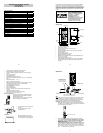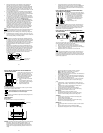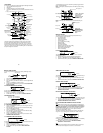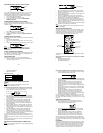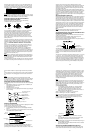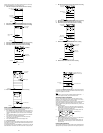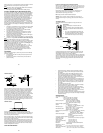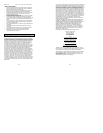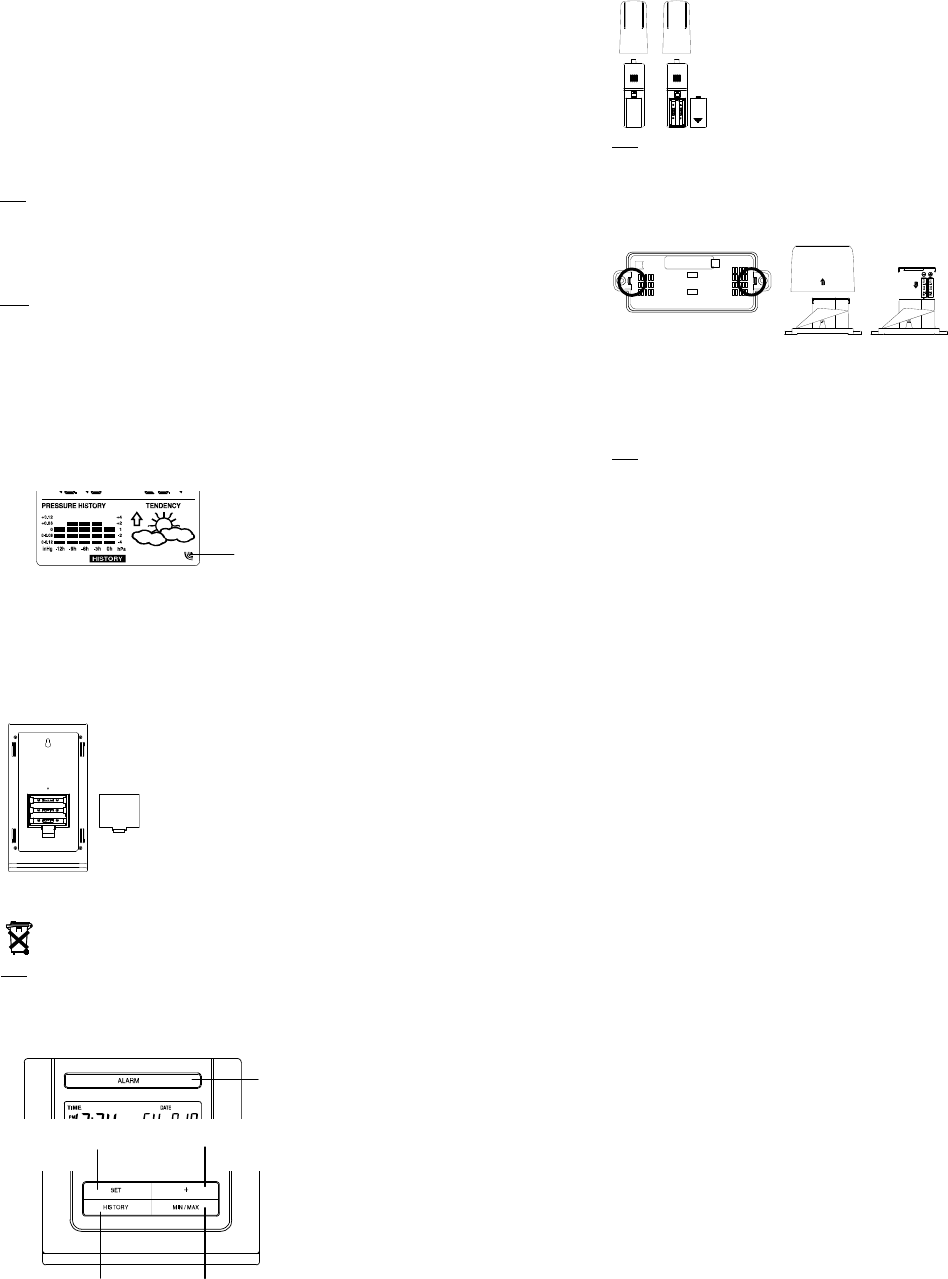
76
4. Afterwards, the Weather Center will start receiving data from the
transmitter. The transmission reception icon will be blinking to
indicate that the station is trying to get the thermo-hygro transmitter
data. The outdoor temperature, humidity, wind data should then be
displayed on the Weather Center. If this does not happen after 135
seconds, the batteries will need to be removed from all units. You will
have to start again from step 2.
5. The transmitter reception icon is now blinking again to indicate that
the station is trying to get the rain sensor data. It will stop blinking
once the rain sensor has been detected. If this does not happen after
135 seconds, you will need to start again from step 2.
6. You may need to check the cable for correct connection and all the
components for correct function by manually turning the wind-gauge
by moving the wind-vane; tilting the rain sensor to hear the impact of
the internal moving seesaw, etc. (see Positioning below).
7. Time and date shall be manually set (See Manual Setting below).
8. After the Weather Center has been checked for correct function with
regard to the above points and found fit, the initial set up of the
weather station system is finished and the mounting of the system
components can take place. It must be ensured however that all
components work properly together at their chosen mounting or
standing locations. If e.g. there appear to be problems with the 915
MHz radio transmission, they can mostly be overcome by slightly
changing the mounting locations or turning the base station.
Note:
The radio communication between the receiver and the transmitters in the
open field reaches distances of max 330 feet, provided there are no
interfering obstacles such as buildings, trees, vehicles, high voltage lines,
etc.
9. Radio interferences created by PC screens, radios or TV sets can in
some cases entirely cut off radio communication. Please consider this
when choosing standing or mounting locations.
Note :
• After batteries are installed in the transmitter, install the batteries in
the weather center to receive the signal from the transmitters as soon
as possible. If the weather center is powered more than 5 hours after
the transmitter is powered, the weather center will never receive
signal successfully from the transmitters. In this case, user will need
to reinstall the batteries from all the transmitters to redo set-up
procedure.
• After batteries are installed, there will be synchronization between
weather center and the transmitters. At this time, the signal reception
icon will be blinking. When the signal is successfully received by the
weather center, the icon will be switched on. (If it is not successful,
the icon will not be shown in LCD) So the user can easily see
whether the last reception was successful (icon on) or not (icon off).
On the other hand, the short blinking of the icon shows that a
reception is in progress.
Transmitter signal
reception icon
77
• If the signal reception is not successful on the first frequency
(915MHz) for 45 seconds, the frequency is changed to 920MHz and
the learning is tried another 45 seconds. If still not successful, the
reception is tried for 45 seconds on 910MHz. This will also be done
for re-synchronization.
HOW TO INSTALL AND REPLACE THE BATTERIES INTO
THE THERMO-HYGRO SENSOR
The outdoor Thermo-hygro sensor works with 2 x
AA, IEC LR6 1.5V batteries. To install and replace
the batteries, please follow the steps below:
1. Uninstall the rain cover of the transmitter.
2. Remove the battery compartment cover.
3. Insert the batteries, observing the correct
polarity (see the marking in the battery
compartment).
4. Replace the battery cover.
Note:
In the event of changing batteries in any of the units, all units need to be
reset by following the setting up procedures. This is because a random
security code is assigned by the thermo-hygro sensor at start-up and this
code must be received and stored by the Weather Center in the first
several minutes of power being supplied to it.
HOW TO INSTALL AND REPLACE THE BATTERIES INTO
THE RAIN SENSOR
The rain sensor works with 2 x AAA, IEC LR3, 1.5V batteries. To install and
replace the batteries, please follow the steps below:
1. Press tabs back to unlock rain sensor cover. (Figure 1)
2. Lift rain sensor cover to access battery compartment. (Figure 2)
3. Insert the batteries, observing the correct polarity (see the marking in
the battery compartment). (Figure 3)
4. Replace the battery cover and the rain cover onto the unit.
Note:
In the event of changing batteries in any of the units, all units need to be
reset by following the setting up procedures. This is because a random
security code is assigned by the rain sensor at start-up and this code must
be received and stored by the Weather Center in the first several minutes
of power being supplied to it.
Figure 1
Figure 2
Figure 3
78
HOW TO INSTALL AND REPLACE THE BATTERIES INTO
THE WEATHER CENTER
The Weather Center works with 3 x AA,
IEC LR6, 1.5V batteries. When the
batteries need to be replaced, the low
battery symbol will appear on the LCD.
To install and replace the batteries,
please follow the steps below:
1. Remove the battery compartment
cover.
2. Insert the batteries observing the
correct polarity (see the marking in
the battery compartment).
3. Replace the battery cover.
BATTERY CHANGE:
It is recommended to replace the batteries in all units every 24 months to
ensure optimum accuracy of these units.
Please participate in the preservation of the environment.
Return used batteries to an authorized depot.
Note:
The stored History record will not be kept after the battery change is done
on the Weather Center.
FUNCTION KEYS:
Weather Center:
The Weather Center has 5 easy-to-use function keys.
SET key
• Press and hold to enter manual setting modes: LCD contrast, Manual
time setting, 12/24 hour time display, Calendar setting, ºF/ ºC
temperature unit, Wind speed unit, Rainfall unit, Pressure unit,
Relative pressure reference setting, Weather tendency threshold
setting, Storm warning threshold setting and Storm Alarm On/ Off
setting
MIN/MAX key
SET key
+ key
HISTORY key
ALARM key
79
• Press to toggle between the display of Mode 1 or Mode 2:
Mode 1: "Wind speed + outdoor temp + rel. pressure"
Mode 2: "Gust + Dew Point temp + rainfall"
(Mode 2 displayed will be shown for 30 seconds. Then it will return to
normal display automatically.)
• In normal display mode, press and hold to switch on/ off the Buzzer
• In the weather alarm setting mode, press and hold to adjust different
alarm value and switch the alarm On/ Off
• Press to activate the reset mode when max or min record is shown
• Stop the alarm during the time alarm or weather alarm ringing
+ key
• In display Mode 1, press to toggle between the display of Preset
alarm time, date, weekday + date, Indoor temp, or second in the time
display
• In display mode 2, press to toggle between the display of Rel.
Pressure, 24 hour rainfall and Total rainfall
• Press to adjust (increase) the level of different settings
• Stop the alarm during the time alarm or weather alarm ringing
• Press to confirm to reset the max/min record
HISTORY key
• Press to display the weather data history records
• Stop the alarm during the time alarm or weather alarm ringing
• Press to exit manual setting mode and alarm setting mode
ALARM key
• Press to enter the time alarm and weather alarm setting mode
• Confirm particular alarm setting
• Press to exit the manual setting mode
• Stop the alarm during the time alarm or weather alarm ringing
• Press to exit max/ min record display mode
MIN/MAX key
• Press to display minimum and maximum records of various weather
data
• Press to adjust (decrease) the level of different settings
• Stop the alarm during the time alarm or weather alarm ringing



